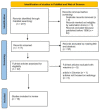The Etiology and Risk Factors of Osgood-Schlatter Disease: A Systematic Review
- PMID: 35740763
- PMCID: PMC9222097
- DOI: 10.3390/children9060826
The Etiology and Risk Factors of Osgood-Schlatter Disease: A Systematic Review
Abstract
The etiology and etiopathogenesis of Osgood-Schlatter Disease (OD) are not fully understood. The aim of this review is to systematically analyze the available literature about the etiology and risk factors of OD. The literature was systematically reviewed using the PRISMA criteria to evaluate all studies published in the last 25 years (between 1996 and 2021) dealing with the etiology of OD. A total of 16 articles were included. The etiology and risk factors of OD are controversial. The main articles focused on muscular factors (mainly tightness of the rectus femoris), alteration of the patellar tendon or extensor mechanism, mechanical factors (repetitive solicitation, trauma, sports), tibial anatomy (tibial slope or tibial torsion), and histological alteration. Associations with ankle kinematic and behavior disorders were also reported. Many theories about the etiology, risk factors, and associated factors of OD have been reported in the literature, but more studies are needed to fully understand the etiopathogenesis of this disorder.
Keywords: Osgood–Schlatter; etiology; pathogenesis; risk factors.
Conflict of interest statement
The authors declare no conflict of interest.
References
Publication types
LinkOut - more resources
Full Text Sources
Medical


